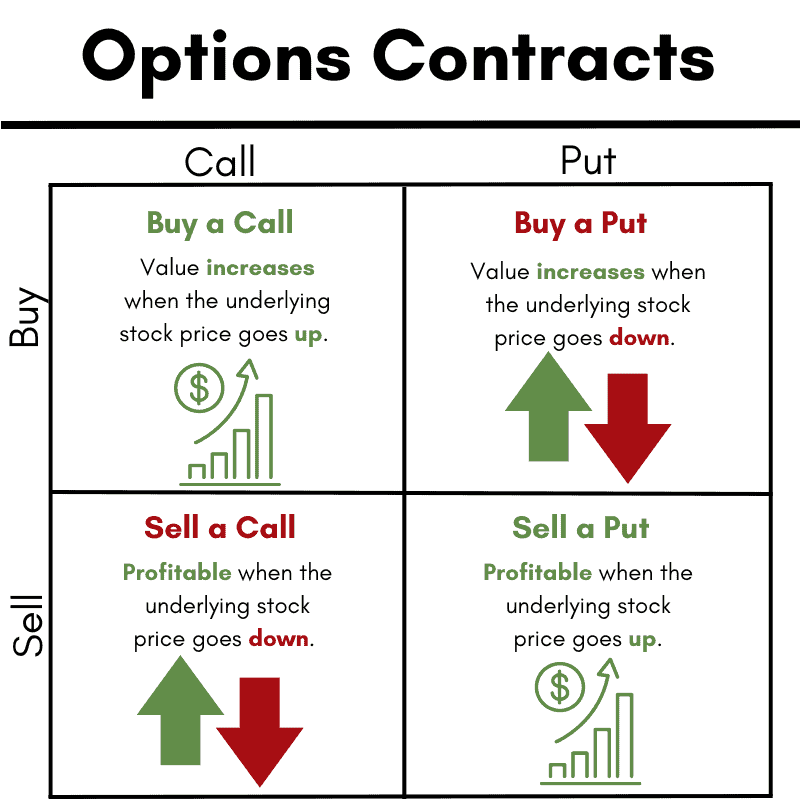How Stock Options Work
Options are a great investing tool that every investor or trader should utilize to grow their wealth. YP Investors will explain how stock options work and the basics of options contracts here.
Let’s start with the definition: An option is a contract that has the right to buy or sell a stock at a specific price until the end date of the contract. Contracts are bought and sold on the market similar to stocks, but each contract for a particular stock will have its own price depending on the specifications.
How Stock Options Work: The basics of an Options Contract
Next let’s go over the specifications of an options contract:
- Each contract is for a specific stock
- One contract represents 100 shares of the stock in the contract. (Example-1 contract MSFT = the right to buy or sell 100 shares MSFT)
- The type of contract: The owner of the contract has the right to either Buy or Sell the stock.
- When a contract has the right to Buy it is referred to as a Call
- When a contract has the right to Sell is referred to as a Put
- Strike Price: The price at which the owner of the contract can buy or sell the stock
- Price: What the market thinks the contract is worth. This depends on the time left in the contract and the price of the stock.
- The expiration date is when the contract expires. All contracts have an expiration date.
Now that you have the specifications of options contracts let’s get into Buying and Selling Options Contracts.

How Stock Options Work: Buying Options Contracts
When buying a contract, you are buying the right to buy or sell the underlying stock. This can be used to protect any stock you hold or as a way to make a large profit. The risk for making a large profit is also very large so be sure to fully understand options before buying them.
How Stock Options Work: Buying a call
- Buying a Call: When buying a single Call contract you are buying the right to purchase 100 shares of the underlying stock at the Strike Price specified in the contract before the contract expiration. The price of the contract will depend on the time left until expiration and the underlying stock price vs the Strike Price. A call contract is “In the money” if the Strike Price is less than the stock price.
- An example of buying a call option: You buy a Call contract for NFLX with a strike price of $300 that expires in one week for a premium of $100. When Buying a Call, the buyer will pay the Seller the premium up-front. The current price of NFLX is $295. The contract will not be worth anything if NFLX is not above $300 at the expiration, and if that was the case you lost $100 because that is what you paid for the premium. On the other hand, the contract will be worth a lot if the price of NFLX rises above $300. Let’s say the price of NFLX is $310, this contract gives you the right to purchase 100 shares of NFLX at $300 (Strike Price.) You end up gross profiting $310-$300 = $10 per share and you can buy 100 so $10*100 = $1,000. Now subtract the $100 premium you paid and your profit is $900.
How Stock Options Work: Buying a put
- Buying a Put: Buying Put contracts are similar to buying calls except now you have the right to sell 100 shares of a stock at the Strike Price in the contract. You would only want to buy a put contract on a stock in which you think the price will drop below the Strike Price. A put contract is “In the money” if the Strike Price is greater than the stock price.
- An example of buying a put option: You buy a Put contract for NFLX with a strike price of $300 that expires in one week for a premium of $100. When Buying a Put, the buyer will pay the Seller the premium up-front. The current price of NFLX is $305. The contract will not be worth anything if NFLX is not below $300 at the expiration, and if that was the case you lost $100 because that is what you paid for the premium (think about it this way-why would people sell NFLX at $300 when the market price is $305? This is why your Put contract is worthless). On the other hand, the contract will be worth a lot if the price of NFLX drops below $300. Let’s say the price of NFLX is $295, this contract gives you the right to sell 100 shares of NFLX at $300 (Strike Price.) You end up gross profiting $300-$295 = $5 per share and you can sell 100 so $5*100 = $500. Now subtract the $100 premium you paid and your profit is $400.
How Stock Options Work: Selling an Options Contract
When selling an options contract, you are acting as the casino in a way. In order to sell one options Call or Put contract you must either own 100 shares of the underlying stock or have the funds to cover the price of 100 shares of the underlying stock. Selling a call or put is literally the opposite side of the deal from buying a call or put.
How Stock Options Work: Selling a call
- Selling a Call: When selling a single Call contract you are in a contract to sell 100 shares of the stock at the Strike Price by the end of the contract date. This way you get paid the premium up-front and allow the contact owner to sell your stock at the Strike Price. The 100 shares of your stock could be sold at the Strike Price anytime the price of the stock is greater than the Strike Price, but if the stock price is lower than the strike price you will keep your 100 shares (again no one will be willing to pay the strike price of $100 when the market price for the stock is only $90). The premium paid for the contract will depend on the time left until expiration and the underlying stock price vs the Strike Price.
- An example of selling a call option: You sell a Call contract for NFLX with a strike price of $300 that expires in one week for a premium of $100. When Selling a Call, the buyer will pay the Seller the premium up-front, so you get $100 instantly. The current price of NFLX is $295. If NFLX never rises above $300 until contract expiration, then you will never have to sell your 100 shares of NFLX for $300 and you just made $100 plus any rise in NFLX stock price (If NFLX stock price rose to $299, you made 299-295 = $4*100 shares=$400 + $100 premium = Net profit of $500.) On the other hand, if NFLX rises above $300 then you will have to sell your 100 shares of NFLX at the strike price of $300 so your gross profit is ($300 – [initial purchase price of NFLX])*100 shares + $100 premium = Gross profit. To get the net profit you have to subtract what you missed out on by selling NFLX at $300. If NFLX rose to $310, you missed out on $1000 ($10*100).
How Stock Options Work: Selling a put
- Selling a Put: When selling a single Put contract you are in a contract to buy 100 shares of the stock at the Strike Price by the end of the contract date. The Seller must have enough funds in place to purchase 100 shares of the stock at the Strike Price. This way you get paid the premium up-front and allow the contact owner to make you purchase 100 shares of the underlying stock at the Strike Price. In order for you to have to purchase the 100 shares of the stock, the stock price must be lower than the Strike Price. If this happens any time before the contract expiration you could be forced to buy 100 shares of the stock at the strike price. If the stock price never falls below the Strike Price then the you (the Seller) don’t have to purchase the underlying stock and you got paid a premium for selling the contract.
- An example of selling a put option: You sell a Put contract for NFLX with a strike price of $300 that expires in one week for a premium of $100. When Selling a Put, the buyer will pay the Seller the premium up-front, so you get $100 instantly. The current price of NFLX is $310. If NFLX never falls below $300 until contract expiration, then you will never have to purchase 100 shares of NFLX for $300 and you just made a net profit of $100. On the other hand, if NFLX falls below $300 then you will have to purchase 100 shares of NFLX at the strike price of $300, so you could lose money. If NFLX is at $295, your net profit is $100 premium + 100*[$295 (stock price) -$300(purchase price)] = $100 – $500 = -$400. You lose money initially on that Sell option, but you now have 100 shares of NFLX so you can hold them as an investment, or you could even sell a call contract with them.
Now that you know how stock options work, use them!
Options are a great tool to add to your portfolios and simply put “options give you options.” Pairing YP Investors Fundamental and Technical analysis with options can help you grow your wealth fast and effectively, but make sure to do your homework and run the numbers twice! YP Investors has made a Stock Options Calculator to help you select the best options based on where you think the stock is heading. We offer this tool for free to anyone!
Options are more risky but an educated YP Investor knows how to utilize them to their advantage. Good luck on your investments.
